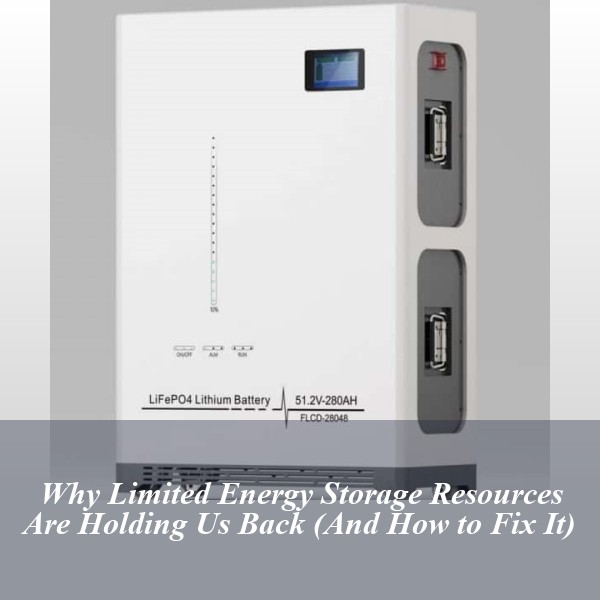Why Limited Energy Storage Resources Are Holding Us Back (And How to Fix It)

The Battery Blues: When Your Grid Acts Like a Phone at 1%
We've all been there - watching our smartphones desperately cling to that last sliver of battery while searching for an outlet. Now imagine our entire power grid suffering from this same limited energy storage resources anxiety. From California's rolling blackouts to Texas' frozen turbines in 2021, our energy infrastructure keeps hitting its "low power mode" at the worst possible times.
The Great Energy Storage Bottleneck
Modern grids face a paradoxical challenge: we're generating more renewable energy than ever (solar grew 22% globally in 2023), but energy storage limitations create bizarre situations like:
- Wind farms being paid to stop producing energy on gusty nights
- Solar plants curbing output during midday peaks
- Utilities firing up fossil fuel plants despite available renewable energy
It's like having a refrigerator that melts ice cream whenever you're not actively eating it. The constrained energy storage capacity forces us to waste perfectly good electrons instead of saving them for later.
Breaking Through the Storage Ceiling
New technologies are emerging to combat our finite energy storage resources, and some solutions might surprise you:
1. The "Tesla Wall" That Saved South Australia
When Elon Musk bet he could build a 100MW battery farm in 100 days (and did it in 63), the Hornsdale Power Reserve became the poster child for grid-scale storage. This lithium-ion behemoth:
- Reduced grid stabilization costs by 90%
- Responds to outages 10x faster than traditional plants
- Stores enough energy to power 30,000 homes
Yet even this engineering marvel only provides 1 hour of backup power - highlighting our ongoing restricted energy storage capabilities.
2. Gravity's Surprising Comeback Tour
Who needs fancy chemistry when you've got good old physics? Energy Vault's gravity storage systems use 6-arm cranes stacking concrete blocks like LEGOs:
- 35-ton blocks lifted during energy surplus
- Controlled descent generates electricity on demand
- 80-90% round-trip efficiency
It's essentially a gigantic version of those click-clack desk toys, but instead of stress relief, we get megawatt-hours.
The Storage Innovation Gold Rush
With the global energy storage market projected to hit $546 billion by 2035 (BloombergNEF), startups are throwing everything at the wall to solve our scarce energy storage resources:
Hot Rocks & Liquid Air
- Molten salt batteries that operate at 240°C (464°F) - basically a thermal smoothie storing solar heat
- Cryogenic energy storage using liquid air (-196°C) that expands 700x when warmed
- Flow batteries with electrolyte "fuel tanks" you can refill like a gas station
Even oil giants are getting in on the action. BP recently invested in a company storing energy in... wait for it... compressed natural gas caverns. Talk about poetic justice!
When Your EV Becomes a Grid Hero
Here's where it gets wild: your future electric car might moonlight as a grid stabilizer. Vehicle-to-grid (V2G) technology turns EVs into rolling batteries:
- Nissan Leaf can power average home for 2 days
- Ford F-150 Lightning's 131kWh battery = 3 days of household use
- California testing "virtual power plants" using 50,000 connected EVs
It's like Uber Pool for electrons - your car earns money while parked by selling stored energy back during peak hours. Take that, gasoline!
The Elephant in the Power Plant
Despite these advances, we're still dancing around the real issue - our energy storage needs are growing faster than storage tech. The U.S. alone requires 100GW of new storage by 2040 to meet clean energy goals (DOE). That's like building:
- 1 new nuclear plant every week for 5 years
- 250,000 shipping-container-sized battery systems
- A lithium mine the size of Central Park
Maybe it's time we stop treating storage as an afterthought and start designing energy systems that actually work when the sun isn't shining and the wind isn't blowing. After all, even the best solar panel can't power your Netflix binge during a lunar eclipse.
- Pre: Why China's Battery Energy Storage Systems Are Powering the Global Shift
- Next: Capacitor Energy Storage Devices: The Unsung Heroes of Modern Power Solutions
Related Contents

Banding Module Lithium Storage Limited: Powering the Future of Energy Storage
Let's start with a shocking fact - the Banding Module Lithium Storage Limited system currently powers enough energy storage capacity to brew 4.7 million espressos simultaneously. While your morning caffeine fix might not need industrial-grade batteries, this quirky statistic reveals how modular lithium solutions are reshaping everything from household gadgets to grid-scale energy storage.

Prisma Energy Storage Limited: Powering the Future Through Advanced Energy Solutions
As global energy demands surge like a Formula 1 car on the final lap, Prisma Energy Storage Limited emerges as a key player in the race for sustainable power solutions. The energy storage market, currently valued at $33 billion, requires sophisticated systems that can store 100 gigawatt-hours annually - enough to power 10 million homes for a year.

Storage Series Integrated Energy Storage System EVADA: The Swiss Army Knife of Energy Management
It's 3 AM, and your factory's energy consumption suddenly spikes like a caffeine-fueled Wall Street trader. With the Storage Series Integrated Energy Storage System EVADA, you'd be sleeping soundly while smart algorithms redistribute power loads automatically. This isn't science fiction - it's today's reality for forward-thinking enterprises adopting integrated energy storage solutions.
